FILE - In this Wednesday, Oct. 26, 2016 file photo, first responders hold a flag on the court as the national anthem is played during a tribute to the victims of the Pulse nightclub shooting prior to an NBA basketball game between the Orlando Magic and the Miami Heat in Orlando, Fla. The attack left 49 people dead; the shooter was killed after a three-hour standoff with police. (AP Photo/John Raoux)
The Associated Press
CHICAGO (AP) - Pardeep Singh Kaleka has surveyed the landscape of an America scarred by mass shootings.
Seven years ago, a white supremacist invaded a Sikh temple in Wisconsin and killed six worshippers - among them, Kaleka's father. Now, whenever another gunman bloodies another town, Kaleka posts a supportive message on social media. Then, later, he may journey to the community to shore up others who share his pain.
He's been to Newtown, Connecticut. Charleston, South Carolina. Pittsburgh. "We've become kind of a family," Kaleka says.
It's true. The unending litany of mass shootings in recent years - the latest, on Friday, leaving 12 dead in Virginia Beach, Virginia - has built an unacknowledged community of heartbreak, touching and warping the lives of untold thousands.
All the survivors, none of them unscathed. Loved ones of the living and dead. Their neighbors, relatives and colleagues. The first responders, the health care workers, the elected officials.
The attacks have changed how America talks, prays and prepares for trouble. Today, the phrase "active shooter" needs no explanation. Schools hold "lockdown drills" to prepare students for the possibility of a shooter. Police and firefighters, tormented by memories of carnage they've witnessed, are treated for post-traumatic stress disorder. Healing centers have opened. Support groups of survivors have formed.
Mayors, doctors, police and other leaders who've endured these crises are paying it forward - offering mentoring and guidance to the next town that has to wrestle with the nightmare.
Former Oak Creek Mayor Stephen Scaffidi remembers the night of the 2012 Sikh temple shooting, when he got a call from the mayor of Aurora, Colorado, where 12 people had recently been killed at a movie theater. "He gave me the best advice ... 'Be calm. Reassure your community. And only speak to what you know," Scaffidi recalls.
Last year, two days after the fatal shooting of 17 students and staff at Marjory Stoneman Douglas High School, Christine Hunschofsky, mayor of Parkland, Florida, met the mother of a 6-year-old killed at Sandy Hook Elementary School. "She said at first it will seem like everyone comes together," the mayor recalls. "Then it seems like a tsunami that hits the community. People become very divided. This is all normal after a mass trauma."
Mass shootings account for a tiny percentage of homicides, but their scale sets them apart. In 1999, the Columbine shooting shocked the nation with its unforgettable images of teens running from the school with their hands up. Today, the public follows these unfolding events through live-streamed video or tweets.
The National Center for PTSD estimates 28 percent of people who have witnessed a mass shooting develop post-traumatic stress disorder (PTSD) and about a third develop acute stress disorder.
April Foreman, a psychologist and board member of the American Association of Suicidology, likens exposure to mass shootings to a flu epidemic.
"Some people might be immune or not susceptible to that strain," she says. "Some people are going to get a little sick, some people are going to be very sick. ... Suicide is like the extreme outcome."
Some first responders diagnosed with PTSD have turned to UCF RESTORES, a clinic at the University of Central Florida that helps military and civilian trauma victims.
Deborah Beidel, the clinic's director, says first responders from Parkland and Pulse face trauma similar to those in combat. About 50 of these workers have been treated, most in a three-week outpatient program that exposes them to the sounds, smells and sights they encountered during the event.
Jimmy Reyes, a 35-year-old Orlando firefighter, suffered panic attacks after Pulse. He was haunted by memories of that morning when he treated bloody, wounded people screaming in agony. As part of the program, he told his story over and over, recalling everything he saw, including one man who'd been shot in the head and another who asked, "Am I going to die?" At certain points, a therapist cued up sounds he'd heard - gunshots, sirens, an explosion.
At first, he says, he cried. By the end of the sessions, he was dry-eyed and calm.
Reyes is better now but he's changed. "I felt like I was normal before Pulse," he says. "I was a very happy guy. ... Now I still deal with depression."
"June 11th, I was normal. Then June 12th happened. I'm a completely different person."
So is Las Vegas trauma surgeon Dave MacIntyre.
In the chaos after the 2017 Route 91 concert shooting, his hospital treated more than 90 severely injured patients in 113 minutes. After 20 years, MacIntyre is now a part-time trauma surgeon looking to leave the operating room. He's enrolled in an MBA program for doctors and plans on becoming a consultant to help hospitals deal with similar challenges.
MacIntyre didn't realize he had PTSD until a program coach noticed his anxiety, stress and short temper. "I find it very hard to talk to family members and give them bad news ... much more so than before," he says.
Brian Murphy, a former Oak Creek police officer, says he didn't have any psychological trauma after the Sikh temple shooting.
He was shot 15 times throughout his body. One bullet remains lodged in his skull; another in his throat, giving him a permanent rasp.
Medically retired, Murphy refuses to dwell on the past.
"It's not like I wake up and say, 'I can't believe this happened.' It's just life now. I don't think there's a tremendous amount of good that comes from looking behind."
__
Sharon Cohen, a Chicago-based national writer, can be reached at scohen@ap.org or on Twitter at https://twitter.com/scohenAP . Follow AP Medical Writer Lindsey Tanner: https://twitter.com/LindseyTanner
In this Saturday, June 1, 2019 photo, Pardeep Singh Kaleka poses for a portrait outside the Sikh Temple in Oak Creek, Wis. Kaleka, whose father was one of six people killed in a 2012 mass shooting at a Sikh temple in Wisconsin, has bonded with those whoâve lost families in other attacks. Heâs traveled to Pittsburgh, Newtown, Conn. and Charleston, S.C., and says thereâs another instant connection with survivors from those communities. âWeâre like family,â he says. (AP Photo/Morry Gash)
The Associated Press
FILE - In this Monday, Aug. 6, 2012 file photo, Sikh worshipers gather for a candlelight vigil after prayer services at the Sikh Religious Society of Wisconsin in Brookfield, Wis. A gunman identified as a former leader of a white supremacist heavy metal band killed six people at the Sikh Temple of Wisconsin in Oak Creek before being shot to death by police. (AP Photo/M. Spencer Green)
The Associated Press
In this Saturday, June 1, 2019 photo, Pardeep Singh Kaleka poses for a portrait in the Sikh Temple in Oak Creek, Wis. At left is a bullet hole in a door frame of the church, left as a reminder of the 2012 shooting. (AP Photo/Morry Gash)
The Associated Press
In this Wednesday, May 29, 2019 photo, Dr. Dave MacIntyre poses for a portrait in the emergency room of the Sunrise Hospital in Las Vegas. He has struggled with PTSD after treating dozens of victims there from a 2017 concert massacre. MacIntyre plans to leave surgery and help train others in coping with similar challenges. He joins a growing community of survivors touched by Americaâs mass shootings. (AP Photo/John Locher)
The Associated Press
FILE - In this Oct. 1, 2017, a woman wounded in a mass shooting at the Route 91 Harvest Festival in Las Vegas is carried from the scene. The attack killed 58 people. A study conducted by a University of Nevada-Las Vegas professor found that PTSD levels for those at the concert remained elevated at least a year later. (Chase Stevens /Las Vegas Review-Journal via AP, File)
The Associated Press
In this Wednesday, May 29, 2019 photo, Dr. Dave MacIntyre poses for a portrait at Sunrise Hospital in Las Vegas. He is part of a vast community of people touched by Americaâs mass shootings. Traumatized after treating dozens of victimsâ from a 2017 Las Vegas concert massacre, MacIntyre plans to leave surgery and help train others in coping with similar challenges. (AP Photo/John Locher)
The Associated Press
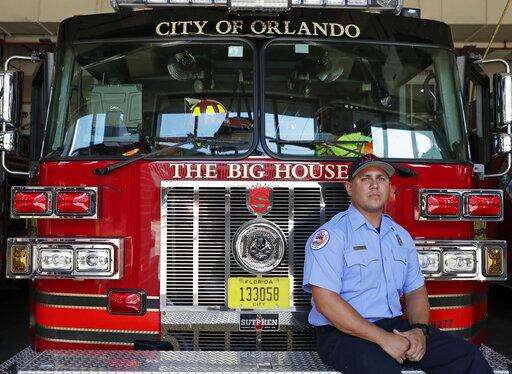
In this Friday, May 24, 2019 photo, Orlando firefighter Jimmy Reyes poses for a portrait next to a firetruck in Orlando, Fla. Reyes enrolled in a program, UCF RESTORES, a clinic at the University of Central Florida that helps first responders, members of the military and some others who've been diagnosed with PTSD. He says he was haunted by the memory of tending to people who'd been shot in 2016 at the Pulse nightclub. The mass shooting left 49 dead. Reyes says the program helped, but he still deals with anxiety. "I'm a completely different person," he says. (AP Photo/John Raoux)
The Associated Press
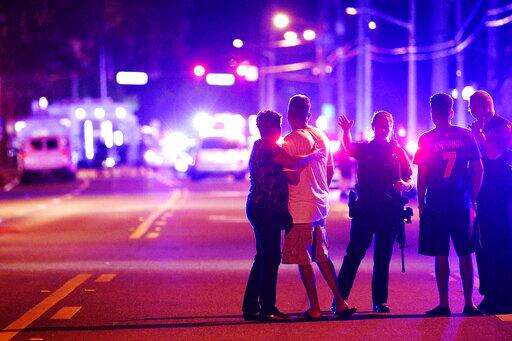
FILE - In this June 12, 2016 file photo, an Orlando Police officer directs family members away from a mass shooting at the Pulse nightclub in Orlando, Fla., that left 49 people dead. The shooter was killed by police after a three-hour standoff. After the tragedy, police were equipped with a new layer of body armor to stop rifle rounds. (AP Photo/Phelan M. Ebenhack, File)
The Associated Press
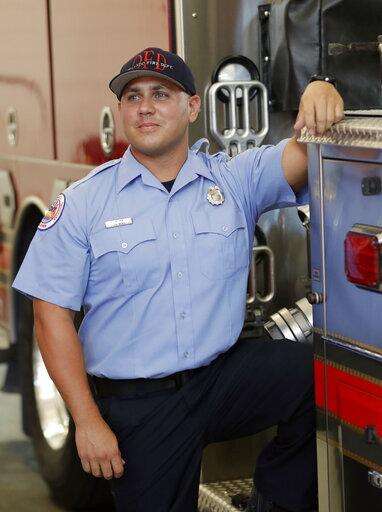
In this Friday, May 24, 2019 photo, Orlando firefighter Jimmy Reyes poses for a portrait at his duty station in Orlando, Fla. He enrolled in a program, UCF RESTORES, a clinic at the University of Central Florida that helps first responders, members of the military and some others who've been diagnosed with PTSD. Reyes says he was haunted by the memory of tending to people who'd been shot in 2016 at the Pulse nightclub. The mass shooting left 49 dead. Reyes says the program helped, but he still deals with anxiety. "I'm a completely different person," he says. (AP Photo/John Raoux)
The Associated Press
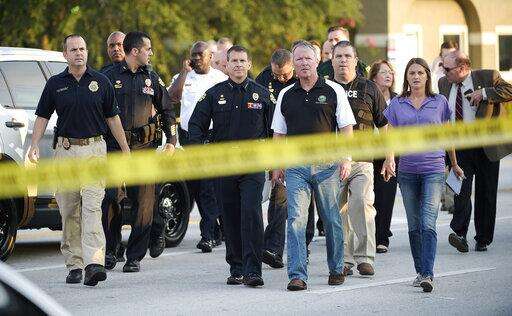
FILE - In this Sunday, June 12, 2016 file photo, Mayor Buddy Dyer, center right, and then-Police Chief John Mina, center left, arrive for a news conference after the mass shooting at the Pulse Orlando nightclub in Orlando, Fla. Mina, now the Orange County, Fla., sheriff, says after the attack, police officers were equipped with another layer of body armor that stops rifle rounds. (AP Photo/Phelan M. Ebenhack)
The Associated Press
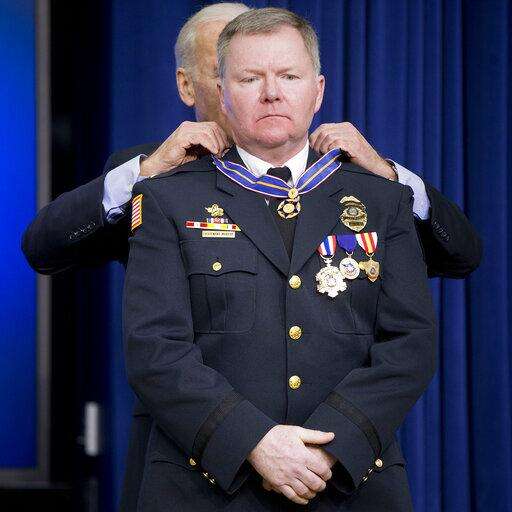
FILE - In this Wednesday, Dec. 11, 2015 file photo, Vice President Joe Biden awards the Medal of Valor to former Lt. Brian Murphy, from the Oak Creek, Wis., police department, during a ceremony in the Old Executive Office Building on the White House Complex in Washington. Medals were awarded to public safety officers who have exhibited exceptional courage. Murphy was shot 15 times by a white supremacist who killed six worshippers in 2012 at a Sikh temple. He refuses to let the shooting dominate his thoughts. "I don't think there's a tremendous amount of good that comes from looking behind," Murphy says. (AP Photo/Pablo Martinez Monsivais)
The Associated Press
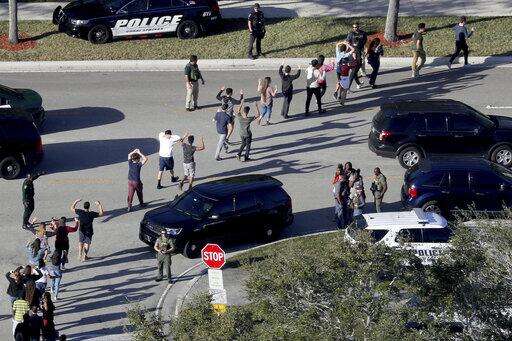
FILE - In this Wednesday, Feb. 14, 2018 file photo, students hold their hands in the air as they are evacuated by police from Marjory Stoneman Douglas High School in Parkland, Fla., after a shooter opened fire on the campus. Seventeen students and staff were killed in the attack. Parkland is one of the communities where, in the wake of mass shootings, wellness centers have opened, offering residents a place to gather and heal. (Mike Stocker/South Florida Sun-Sentinel via AP)
The Associated Press
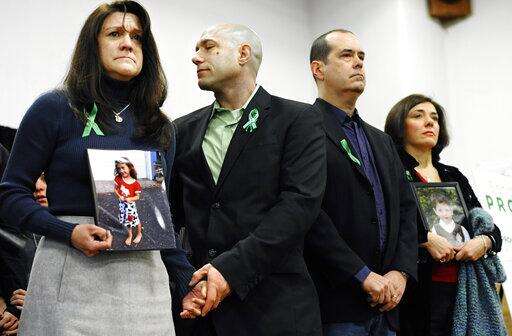
FILE - In this Monday, Jan. 14, 2013 file photo, from left, Jennifer Hensel and Jeremy Richman, parents of Sandy Hook School shooting victim Avielle Rose Richman; and David and Francine Wheeler, parents of victim Benjamin, attend a news conference at Edmond Town Hall in Newtown, Conn. One month after the mass school shooting at Sandy Hook Elementary School, the parents joined a grassroots initiative called Sandy Hook Promise to support solutions for a safer community. In March 2019, Richman committed suicide. (AP Photo/Jessica Hill)
The Associated Press
FILE - In this Thursday, Feb. 22, 2018 file photo, Parkland, Fla., Mayor Christine Hunschofsky speaks during a meeting with President Donald Trump and state and local officials on school safety, in the Roosevelt Room of the White House in Washington, D.C.. The mayor and others who've experienced mass shootings in their communities have bonded, comforting and offering advice to one another. (AP Photo/Evan Vucci)
The Associated Press
FILE - In this Tuesday, April 20, 1999 file photo, four unidentified young women head to a library near Columbine High School where students and faculty members were evacuated after two student gunmen went on a shooting rampage in the school in the Denver suburb of Littleton, Colo. The attack left 12 students and one teacher dead. These horrifying images of tearful students would be repeated in other mass shootings at schools in later years. (AP Photo/Kevin Higley)
The Associated Press
FILE - In this Saturday, June 1, 2019 file photo, Lisa Dunaway, center, of Virginia Beach, Va., holds hands with other mourners during a vigil in response to a fatal shooting at a municipal building in Virginia Beach, Va. A longtime city employee opened fire at the building Friday, killing several before police shot and killed him, authorities said. (AP Photo/Patrick Semansky)
The Associated Press
FILE - In this Saturday, Dec. 15, 2012 file photo, a U.S. flag flies at half-staff on Main Street in honor of the 26 students and staff killed in a mass shooting at the Sandy Hook Elementary school in Newtown, Conn. Most of those killed in the attack were 6-and 7-year-old students. The shooter took his own life. (AP Photo/David Goldman)
The Associated Press